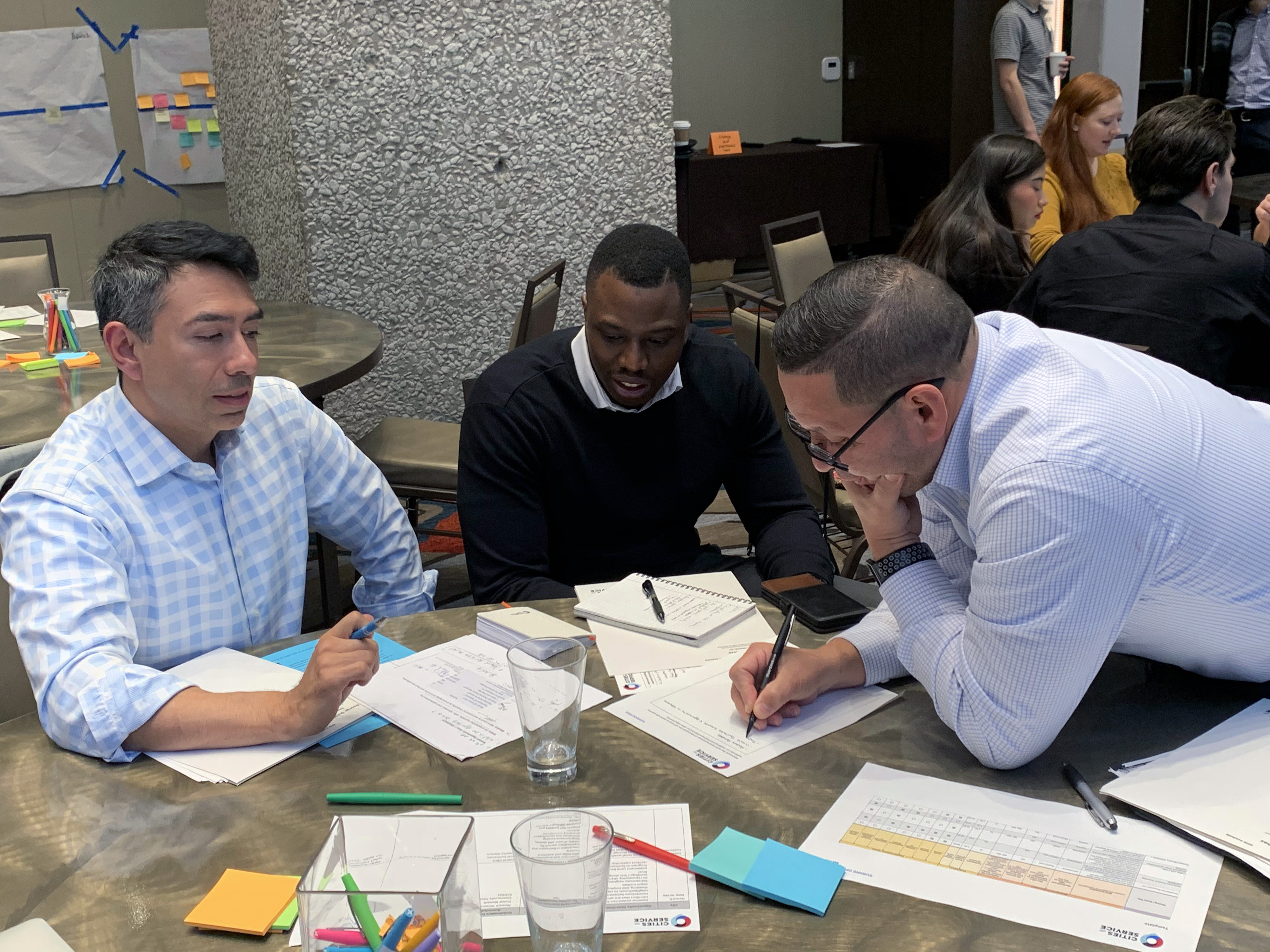Cities of Service launched the Guiding Opportunities program in 2019 to ensure that decision making about Opportunity Zone investments includes community voices.
The Federal Government enacted the Opportunity Zone program as part of the 2017 Tax Cuts and Jobs Act to stimulate economic development and mobility in low-income communities by encouraging investment with tax incentives. Community engagement is an important part of setting priorities for where and how these new investments are made.
In partnership with The Rockefeller Foundation and with additional support from The Prudential Foundation, the Cities of Service Guiding Opportunities program provided coaching to Chief Opportunity Zone Officers in five cities. Cities of Service provided each city with $25,000 and technical assistance and placed full-time AmeriCorps VISTA members in each city hall to build capacity for resident engagement.
The nature of Opportunity Zones presents a number of challenges. In particular, the Federal program lacks a formal role for local government and residents. Despite this and the interruptions caused by the COVID-19 pandemic, Cities of Service helped city officials and AmeriCorps VISTA members work with local communities, businesses, and funders to shape strategies for Opportunity Zone development.
We have gathered best practices and guidance based on our experience to help government leaders, economic development authorities, and community organizers effectively deliberate with community members and enable more equitable Opportunity Zone development in their own cities.
City officials should have clear goals for resident engagement. Goals should be tied to an established plan for Opportunity Zones.
City leaders need a clearly articulated purpose when engaging with residents about any subject. This ensures that participants feel that their input and time are being used productively.
Establishing clear goals is especially important in the context of Opportunity Zones, where local government can influence investment and inform stakeholders but does not have direct oversight over development. Tying engagement to the city’s larger strategy helps city leaders choose achievable goals, determine appropriate engagement activities, and set realistic expectations.
Citywide assessments and plans also typically include strategies for working with previously-engaged communities and organizations, which can serve as a starting point for planning grassroots outreach.
Washington’s Plans Lead to Better Engagement: City leaders in Washington, D.C., established a strategy for their Opportunity Zones prior to the start of the Guiding Opportunities program. Their overarching goal was to align investments with community priorities and maximize the benefit to existing residents. With this goal in mind, the city set priorities for investments, such as delivering new, neighborhood-serving amenities; providing investment capital and growth opportunities for small businesses; and creating jobs for residents.
This overall approach, in turn, helped the city develop specific objectives for engaging residents, including:
- raising awareness among residents, businesses, and community organizations in Opportunity Zones about the tax incentive and the potential impact of investments;
- increasing community participation in shaping development and investments; and
- identifying and monitoring community-led projects.
City officials were able to strategically focus their engagement activities based on these objectives. For example, they worked with community organizations to determine the best way to reach residents, small businesses, and organizations located in Opportunity Zones. City staff also tabled at events in Opportunity Zones in order to reach residents who do not usually attend city functions. They were able to reach 45 stakeholders in Opportunity Zones to discuss their needs and explore available resources for financing, local development, and housing.
The result of basing their activities on a clear strategy was that the feedback, ideas, and new connections that arose from engaging residents advanced the goals of the city.
City government can play an important role as educator and matchmaker, convening stakeholders, investors, and residents.
While local officials do not have direct oversight of the Opportunity Zone program, they can use their large reach and existing connections to influence investors and inform community stakeholders about what the program has to offer.
City leaders can draw on their relationships with local businesses, chambers of commerce, nonprofit partners, and community leaders to create forums and host events. These can be done both virtually and in person.
By strategically bringing together these stakeholders, city officials create opportunities to advise and guide potential investors and connect them with projects that align with city goals and serve the community. Local officials can also help investors and small businesses in historically marginalized communities take advantage of the Opportunity Zones tax incentives through their outreach, informing them about available support and opportunities to provide input.
Workshops Reveal Community Needs in Oakland: In Oakland, California, AmeriCorps VISTA members and city staff planned a series of workshops and in-person events to educate small businesses, property owners, and residents about Opportunity Zones. They held meetings with leaders of local business associations and nonprofits and attended a number of events as guests, allowing them to interact with hundreds of residents and raise awareness of the Guiding Opportunities program and investment opportunities.
Through their outreach to Black small business owners, the city found that many developers of color did not have the capacity to take advantage of Opportunity Zone tax breaks. This indicated the need for city officials to inform the community about additional resources available to small businesses in the area. As the COVID-19 pandemic further threatened some of these same communities, Oakland developed community-based responses to increase resiliency and address inequity, such as a Black Developers Forum.
“People are excited about the opportunity to work together. They’re willing to work with the city and want to see what the city is going to do.” – Daffney Moore, Chief Opportunity Zone Officer, St. Louis
St. Louis Establishes Stakeholder Working Groups: St. Louis, Missouri, has likewise done extensive work to convene stakeholders. They organized a community engagement working group of grassroots organizations from the north side of the city, where several Opportunity Zones are located and there are many vacant properties. The group is organized to educate residents and to work with the Chief Opportunity Zone Officer, neighborhood groups, and small investors to encourage equitable investment. City staff also meet regularly with an Opportunity Zones Working Group, which includes committees focused on funding and potential investors, as well as identifying potential projects.
Atlanta Connects Investors with Projects Online: Atlanta, Georgia, created a web platform for developers, investors, and businesses. The website includes a map of Opportunity Zones, which can be overlaid with additional incentives and opportunities available in those areas. Users can also access other resources, such as financing information and a tool provided by The Opportunity Exchange. This tool allows users to submit an Opportunity Zone project, which can then be viewed by investors and fund managers looking for investment opportunities.
Thirty projects have been published on the platform, with another 20 to be added soon. The city reports that funders have been regularly contacting project sponsors after viewing profiles on the site to learn more and explore potential partnerships.
Pilot projects model new uses for vacant land and empty shops, spurring new possibilities.
City leaders can help guide investment by working with residents to showcase what is possible in Opportunity Zones, inspire investors and developers, and build community enthusiasm around new uses for unused space and empty lots.
Local officials can work with residents, nonprofits, and businesses to model and pilot projects, demonstrating what equitable use of space could look like. Pilot projects might include pop-up shops or turning empty lots into temporary public parks. These pilot projects should be based on the needs identified by the community and on the city strategy for Opportunity Zones. Successful pilots can be pitched to investors to make sustainable additions to the neighborhood and expanded to other Opportunity Zones.
Creative Placemaking in Washington: Washington, D.C., in partnership with Local Initiatives Support Corporation (LISC), launched a creative placemaking initiative to support collaborations between minority-owned small businesses and local artists. City leaders hope to encourage economic stability for small businesses through increased foot traffic and to grow community pride by celebrating the history of Opportunity Zone neighborhoods.



